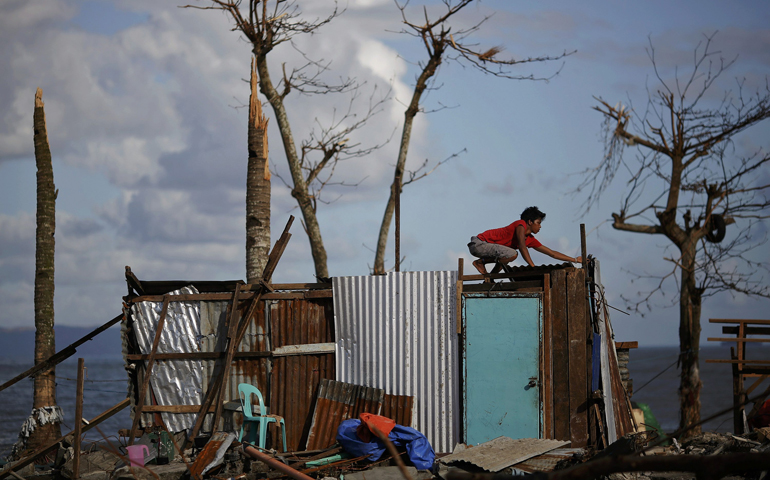
A man repairs his house, which was damaged by Typhoon Haiyan, at a coastal area south of Tacloban Nov. 16. (CNS/Reuters/Damir Sagolj)
But for the tragedy in the Philippines, 2013 is ending as a quiet year for humanitarian events, right?
Not necessarily.
True, in some ways, 2013 represented "more of an 'under-the-radar' period," said Catholic Relief Services' Sean Callahan, noting that not even the on-the-ground horrors of the war in Syria seemed to get the sustained attention of many in the world, including the American public.
Certainly, the effects of Typhoon Haiyan on the Philippines made that event the "major purely humanitarian disaster of 2013," Callahan said, with the Syria emergency being the major "man-made" humanitarian disaster.
"The need in both cases is extreme, but in the case of Syria, there are security and political concerns where in the Philippines, the power of that natural disaster overwhelmed human infrastructure -- roads, homes and airports," said Callahan, CRS's chief operating officer.
"The combination of these two disasters as well as other disasters that are not on the scale of the Philippines and Syria," he said, "are putting pressure on the international humanitarian assistance infrastructure and resources."
The result? The most vulnerable are also those suffering the most.
Anne Street, who heads humanitarian policy at London-based CAFOD, the official Catholic aid agency for England and Wales, agreed. She told NCR the "overall trend is that the scale and depth of humanitarian needs is outpacing the ability of the system to respond." Consolidated appeals coordinated by the United Nations "are typically hugely underfunded," she said, and the Syria response has been no different.
That is also been the case with events that did not get even a fraction of the attention the Syrian conflict or Typhoon Haiyan received, such as ongoing humanitarian problems in Congo, South Sudan and Colombia.
The issue of climate change largely "got waylaid" this year, Callahan said. But Typhoon Haiyan and the fear of similar "mega-disasters" in the future may revive calls for the global community to redouble efforts to confront climate change.
Callahan said other under-the-radar trends included a swiftly changing Africa, where some countries are experiencing robust economic growth, especially Mozambique, Rwanda, Tanzania and Uganda. Such changes could upend traditional aid relationships between Africa and northern countries, Callahan said, though it is also true that a number of African states, including South Sudan and the Central African Republic, remain mired in poverty.
Callahan also cited increased urbanization throughout the world, where problems like hunger and malnutrition are becoming more acute and noticeable in growing urban areas.
Street said one of her under-the-radar trends for 2013 would be the increasing prominence of new donors and actors in the humanitarian field, such as the Gulf States and Islamic humanitarian groups. Turkey has emerged as a growing humanitarian power, donating considerable funding to recent drought responses and to needs in the Syrian refugee crisis.
"There is increasing realization among traditional donors that they cannot meet all needs," Street said.
Christian-Muslim tensions also continued in numerous locales, perhaps most notably in Syria and Kenya. Against that backdrop, a positive force was Pope Francis, whom Callahan praised as perhaps the globe's most visible proponent of peace.
"Pope Francis has given peace more credibility," Callahan said. "He has been a great force for that" -- and the world is noticing. On a flight to Rome soon after Francis was named pope, Callahan spoke to religious leaders on his plane and was struck by how many of those he spoke to called Francis "their pope, too."
"They said, 'He's talking our language,' " Callahan said.
Other positive signs in 2013? Acts of solidarity and awareness among church communities. Street said a "day of prayer" for Syria "was hugely inspiring," helping "highlight the suffering and the depth of the Syrian crisis amongst parishes throughout England and Wales, as well as around the world."
Though such signs of hope were visible, many intractable issues remained unsolved. One was global hunger. Though the number of hungry people in the world has been decreasing, close to 1 billion people in the world remain hungry. And problems related to hunger, nutrition and malnourishment persist in nearly all parts of the world, according to a study titled "State of Food Insecurity in the World" released Oct. 1 by the Food and Agriculture Organization, the International Fund for Agricultural Development, and the World Food Program.
One in eight people in the world -- some 842 million in all -- are living with chronic hunger, meaning they are "not getting enough food to conduct an active life," the report stated.
Still, there was encouraging news. The number of those classified as chronically hungry in 2011-2013 declined from 868 million, the number in the previous reporting cycle of 2010-2012. And there has been overall progress since 1990-1992, with the overall number of the world's undernourished dropping by 17 percent.
That could result in the world coming close to one of the targets of the first of eight Millennium Development Goals -- reducing by half the number of those suffering from hunger from 1990 to 2015.
Another CRS humanitarian worker accentuated the positive in the overall trends cited in the hunger report.
"There has been significant progress, and that is to be celebrated," Bruce White, a CRS policy adviser, told NCR. He cited in particular progress in China, where a combination of economic growth and a national commitment to reducing hunger has resulted in fewer hungry people.
Those countries still facing hunger problems, such as in sub-Saharan Africa, still struggle with overall conditions of severe poverty and lack of robust governmental intervention to reduce hunger and malnutrition, White said.
"Often in such countries, there are problems of governance" where there are few resources for social protection or social safety nets, or for effective rural and agricultural programs, he said. "There are places where the hurdles are still formidable."
The leaders of the groups who wrote "State of Food Insecurity in the World," José Graziano da Silva, Kanayo F. Nwanze and Ertharin Cousin, said in the foreword of the report that with "a final push in the next couple of years," the world could reach the development goals' target on hunger.
"Policies aimed at enhancing agricultural productivity and increasing food availability, especially when smallholders are targeted, can achieve hunger reduction even where poverty is widespread," the UN leaders said in the report.
"When they are combined with social protection and other measures that increase the incomes of poor families, they can have an even more positive effect and spur rural development, by creating vibrant markets and employment opportunities, resulting in equitable economic growth."
The report noted that "significant reductions in both the estimated number and prevalence of undernourishment have occurred in most countries of Eastern and South Eastern Asia, as well as in Latin America."
But serious and marked differences persist in other parts of the world. The region with the highest level of undernourishment remains sub-Saharan Africa, with only "modest progress" in recent years. "Western Asia shows no progress, while Southern Asia and Northern Africa show slow progress," the report said.
Among other findings, the report noted that food security -- the availability of food, as well as its access and utilization -- is a "complex situation." There can be varying hunger-related conditions in any one country. The report also noted that improving conditions related to hunger and malnutrition "require a range of food security and nutrition-enhancing interventions in agriculture, health, hygiene, water supply and education, particularly targeting women."
The report also noted that there are social payoffs when policies "aimed at enhancing agricultural productivity and increasing food availability" are implemented, particularly at the grass roots.
When such programs are "combined with social protection and other measures that increase the incomes of poor families to buy food, they can have an even more positive effective and spur rural development, by creating vibrant markets and employment opportunities, making possible equitable economic growth," the report said.
White said the role of humanitarian groups like his is to fill in gaps, such as a CRS feeding program underway in the southern Africa country of Burundi to prevent "stunting" in children. Such programs do much good, he said, but ultimately, responsibility for feeding a country's population comes down to its sovereign government.
The "State of Food Insecurity in the World" was released a week after UN member states issued a report card of sorts on the progress made on the Millennium Development Goals. The UN members said the global goals provided a common vision for nations to follow and contributed to progress in some areas. But they also acknowledged that gaps remain and that ongoing efforts are still needed in improving life for those in developing countries.
Michel Roy, secretary general of the global Catholic humanitarian alliance Caritas Internationalis, said, "We cannot be satisfied with this. We have to target zero poverty, as every human being has the same right to live a dignified life."
[Chris Herlinger is a New York-based freelance journalist and a frequent contributor to NCR on humanitarian and international issues. He is also the senior writer for the humanitarian agency Church World Service.]




